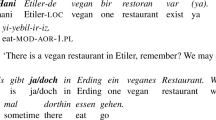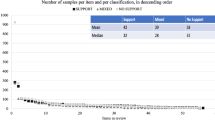Abstract
Takayama (1999) recently proposed a new rendaku-based vocabulary stratum hierarchy for Japanese, in which what he terms a ‘vulgarized Sino-Japanese’ stratum is treated separately from, and occupies a more core position than, the traditional Sino-Japanese (SJ) stratum. However, Takayama deliberately excludes from his analysis one particular subset of the SJ vocabulary layer, monomorphemic SJ lexemes (SJ mononoms), and focuses exclusively on bimorphemic SJ lexemes (SJ binoms), claiming that analytical difficulties caused by another voicing phenomenon known as shindaku(Okumura (1952)), which occurs only in the SJ stratum, hampers any attempt to ascertain the frequency of rendaku amongst SJ mononoms. As it has been established that the stratum to which the initial element in a dual element noun compound belongs is not a factor conditioning rendaku in the second element (Ohno (2000)), examining comparatively under-researched hybrid noun compounds whose second element is a SJ mononom allows us to bypass any interference caused by shindakuand establish the frequency of rendaku occurrence amongst SJ mononoms. Such a corpus of hybrid noun compounds whose second element is a SJ mononom is presented here, to the author’s knowledge the first time any such corpus has appeared in print, an analysis of which shows that rendaku is in fact more than twice as likely to occur amongst SJ mononoms as amongst SJ binoms. When a further dynamic, the faithfulness of SJ mononoms to a prosodic size factor proposed by Rosen (2001) for native Japanese lexemes, is taken into consideration, it is clear that not only, at the very least, must Takayama’s vulgarized SJ stratum be amended to incorporate SJ mononoms, but that there is also a strong case for proposing an independent vulgarized SJ mononom stratum occupying an even more central position than the vulgarized SJ binom stratum.
Similar content being viewed by others
References
John DeFrancis (1984) The Chinese Language University of Hawaii Press Honolulu
Bjarke Frellesvig (1995) A Case Study in Diachronic Phonology—The Japanese Onbin Sound Changes Aarhus University Press Aarhus
Haruka Fukuzawa Kitahara Mafuyu (2001) Domain-Relative Faithfulness and the OCP: Rendaku Revisited Weijer Jeroenvan de Nishihara Tetsuo (Eds) Issues in Japanese Morphology and Phonology Mouton de Gruyter Berlin and New York 85–109
Shosuke Haraguchi (2001) On Rendaku BibInstitutionalEditorNameThe Phonological Society of Japan (Eds) Phonological Studies Vol. IV Kaitakusha Tokyo 9–32
Shinkichi Hashimoto (1932) ArticleTitleKokugo Ni Okeru Bibōin [Nasalized Vowels in the National Language] Hōgen 2 IssueID2 1–7
Hayashi, Chikafumi and Tadayuki Yuzawa (1980) ‘Nihonkanjion [The Readings of Japanese Sinographs],’ in Kokugo Gakkai [Society for the Study of the National Language] (eds.), Kokugogaku Daijiten [The Great Dictionary of National Language Studies], Tōkyōdō, Tokyo, pp. 674–678
Junko Itō Mester Armin (1986) ArticleTitleThe Phonology of Voicing in Japanese:Theoretical Consequences for Morphological Accessibility Linguistic Inquiry 17 49–73
Junko Itō Mester Armin (1995) Japanese Phonology Goldsmith John (Eds) The Handbook of Phonological Theory Blackwell Cambridge Mass 817–838
Junko Itō Mester Armin (1999) The Phonological Lexicon Tsujimura Natsuko (Eds) The Handbook of Japanese Linguistics Blackwell Oxford 62–100
Junko Itō Mester Armin Padgett Jaye (1995) ArticleTitleLicensing and Underspecification in Optimality Theory Linguistic Inquiry 26 571–613
Haruhiko Kindaichi (1976) ArticleTitleRendaku No Kai [Explaining Rendaku] Sophia Linguistica 2 1–22
Paul Kiparsky (1968) How Abstract is Phonology? Fujimura Osamu (Eds) Three Dimensions of Linguistic Theory TEC Tokyo 5–56
Gisabro Kiyose (1985) ArticleTitleHeianchō Hagyōshiin-p Onron [Evidence that Modern Japanese h- was p-in the Heian Period],’ Onsei no Kenkyū [Journal of the Phonetic Society of Japan] 21 73–87
Hideo Komatsu (1981) Nihongo No Sekai 7: Nihongo No On’in [The World of Japanese Vol. VII: Japanese Phonology] Chuōkōronsha Tokyo
Lyman Benjamin (1894) ‘Change from Surd to Sonant in Japanese Compounds,’ Oriental Club of Philadelphia, 1–17
Kazuo Mabuchi (1971) Kokugo On’inron [The Phonology of the National Language] Kasama Shoin Tokyo
Martin, Samuel E. (1952) ‘Morphophonemics of Standard Colloquial Japanese,’ Language28:3 (Part 2, Supplement)
E. Martin Samuel (1975) A Reference Grammar of Japanese Yale University Press New Haven and London
E. Martin Samuel (1987) The Japanese Language Through Time Yale University Press New Haven and London
Masuda Kō (Eds) (1989) Kenkyūsha’s New Japanese–English Dictionary EditionNumber4 Kenkyūsha Tokyo
James McCawley (1968) The Phonological Component of a Grammar of Japanese Mouton Den Haag
Andrew Miller Roy (1967) The Japanese Language Chicago University Press Chicago
Takeo Miyake (1932) ArticleTitleDakuonkō [Some Observations on Voicing] Onsei No Kenky ū 5 135–190
Hideo Miyake Marc (2003) Old Japanese: A Phonetic Reconstruction RoutledgeCurzon London
Yoshio Nakagawa (1966) ArticleTitleRendaku, Rensei (Kashō) No Keifu [A Genealogy of Sequential Voicing and Sequential Non-Voicing (Working Label)] Kokugokokubun 35 IssueID6 302–314
Toraya Nishio (2002) Goshu [Word Classes] Saitō Michiaki (Eds) Asakura Nihongo Kōza 4: Goi, Imi [The Asakura Japanese Language Course, Vol. 4: Vocabulary and Meaning] Asakura Shoten Tokyo 29–53
Kazutoshi Ohno (2000) The Lexical Nature of Rendakuin Japanese Nakayama Mineharu J.Quinn Charles (Eds) Japanese/Korean Linguistics Volume 9 CSLI Publications Stanford 151–164
Mitsuo Okumura (1952) ArticleTitleJion No Rendaku Ni Tsuite [Sequential Voicing in Sino-Japanese] Kokugokokubun 21 IssueID6 8–22
Mitsuo Okumura (1972) Kodai no On’in [Old Japanese Phonology] Nataka Norio (Eds) Kōza Nihongoshi 2: On’inshi, Mojishi [A Course in the History of the Japanese Language, Vol. II: Historical Phonology and Orthographical History] Taishūkan Tokyo 58–171
ōtsu Yukio (1980) ‘Some Aspects of Rendaku in Japanese and Related Problems,’. in Yukio ō tsu and Ann Farmer (eds.), Theoretical Issues in Japanese Linguistics, MIT Working Papers in Linguistics 2, pp. 207–227
Yūjirō Ozaki Tsuro Haruo Nishioka Hiroaki Yamada Katsumi Yamada Toshio (Eds) (1992) Daijigen Kadokawa Shoten Tokyo
G. Pulleyblank Edwin (1991) Lexicon of Reconstructed Pronunciation in Early Middle Chinese, Late Middle Chinese, and Early Mandarin University of British Columbia Press Vancouver
Rice, Keren (forthcoming, 2005) ‘Sequential Voicing, Postnasal Voicing, and Lyman’s Law Revisited,’ to appear in Jeroen van de Weijer Kensuke Nanjō and Tetsuo Nishihara (ed.). Voicing in Japanese. Mouton de Gruyter, Berlin and New York.
Rosen, Eric Robert (2001) Phonological Processes Interacting with the Lexicon: Variable and Non-Regular Effects in Japanese Phonology, PhD dissertation, University of British Columbia.
Bohdan Saciuk (1969) ArticleTitleThe Stratal Division of the Lexicon Papers in Linguistics 1 464–532
Kiyoshi Satō (1982) Waseinihongo no Rekishi [The History of Made-in-Japan Sino-Japanese Lexemes] Morioka Kenji Miyaji Yutaka Teramura Hideo Kawabata Yoshiaki (Eds) Kōza Nihongogaku 4: Goishi [A Course in the Japanese Language,Vol. IV: The History of Vocabulary] Meiji Shoin Tokyo 70–91
Masayoshi Shibatani (1990) The Languages of Japan Cambridge University Press Cambridge
Shinmura Izuru (ed.) (1996) Kōjien, in Fujitsu Corporation Sūpīa Tōgō Jiten 97 [Consolidated Super Dictionary], v1.3, CD-ROM
Tomoaki Takayama (1999) Shakuyōgo no Rendaku/Kōonka Ni Tsuite [Sequential Voicing and Fortis in Loan Vocabulary],’Report of the Special Research Project for the Typological Investigation of Languages and Cultures of the East and West1 Tsukuba University Tsukuba 375–385
Takayama Tomoaki (forthcoming, 2005) ‘Rendaku in Loanwords,’ to appear in Jeroen van de Weijer, Kensuke Nanjō and Tetsuo Nishihara (eds.), Voicing in Japanese, Mouton de Gruyter, Berlin and New York.
Leone Takeuchi (1999) The Structure and History of Japanese: From Yamatokotoba to Nihongo Pearson Education Harlow, Essex
Suzuko Tamura (1972) ArticleTitleGoseigo ni Mirareru Onsokōtai [Phoneme Alternation in Compounds and Their Derivatives],’ Kōza Nihongo Kyō iku 8 116–144
Akio Tanaka (2002) Goikenkyū No Shosō [Aspects of Vocabulary Research] Saitō Michiaki (Eds) Asakura Nihongo Kōza 4: Goi, Imi [The Asakura Japanese Language Course, Vol. 4: Vocabulary and Meaning] Asakura Shoten Tokyo 1–28
Minoru Umegaki (1963) Nihongairaigo no Kenkyū[Studies in Foreign Loan Words in Japanese] Kenkyūsha Tokyo
Marshall J. Unger (1993) Studies in Early Japanese Morphophonemics EditionNumber2 Indiana University Linguistics Club Publications Bloomington
Vance, Timothy J. (1979) Nonsense-word Experiments in Phonology and their Application to Rendaku in Japanese, PhD dissertation, University of Chicago.
Vance Timothy J. (1980a) ‘Comments on ōtsu (1980),’ in Yukio ōtsu and Ann Farmer (eds.), Theoretical Issues in Japanese Linguistics, MIT Working Papers in Linguistics 2, pp. 229–236
Timothy J. Vance (1980) ArticleTitleThe Psychological Status of a Constraint on Japanese Consonant Alteration Linguistics 18 245–267
Timothy J. Vance (1982) ArticleTitleOn the Origin of Voicing Alteration in Japanese Consonants Journal of the American Oriental Society 102 333–341
Timothy J. Vance (1987) An Introduction to Japanese Phonology State University of New York Press Albany
Timothy J. Vance (1996) ArticleTitleSequential Voicing in Sino-Japanese Journal of the Association of Teachers of Japanese 30 IssueID1 22–43
Vance, Timothy J. (forthcoming, 2005) ‘Rendaku in Inflected Words,’ to appear in Jeroen van de Weijer, Kensuke Nanjō and Tetsuo Nishihara (eds.), Voicing in Japanese, Mouton de Gruyter, Berlin and New York.
Toshirō Watanabe Skrzypczak Edmund Paul Snowden (Eds) (2003) Kenkyū sha’s New Japanese–English Dictionary EditionNumber5 Kenkyūsha Tokyo
Günther Wenck (1959) Japanische Phonetik Vol. 4: Erscheinungen und Probleme des Japanischen Lautwandels Otto Harrassowitz Wiesbaden
Toshio Yamada (1992) Kanji ni Tsuite [Sinography] Ozaki. Yūjirō (Eds) et al. Kanjigen Kadokawa Shoten Tokyo 2039–2064
Author information
Authors and Affiliations
Corresponding author
Rights and permissions
About this article
Cite this article
Irwin, M. Rendaku-Based Lexical Hierarchies in Japanese: The Behaviour of Sino-Japanese Mononoms in Hybrid Noun compounds. J East Asian Linguis 14, 121–153 (2005). https://doi.org/10.1007/s10831-004-6306-9
Received:
Revised:
Issue Date:
DOI: https://doi.org/10.1007/s10831-004-6306-9




